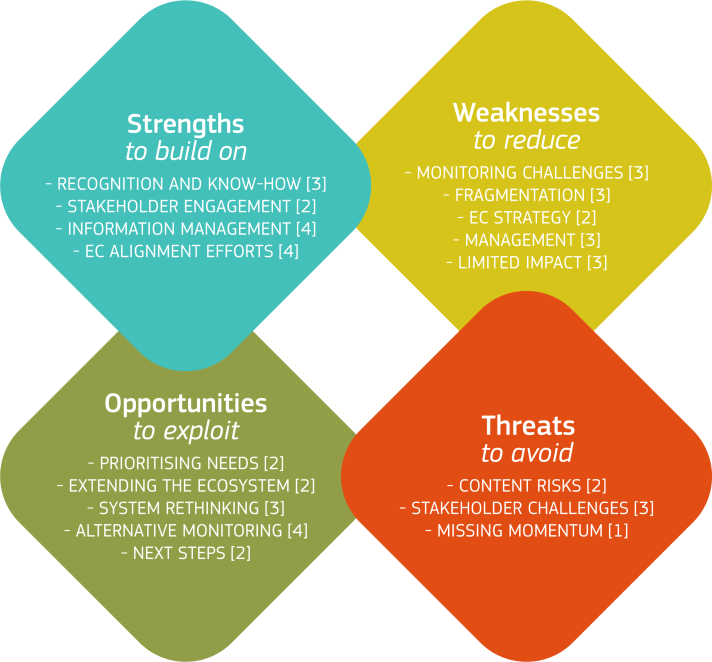
Digital technologies evolve quickly, and with them the related policy demands and needs, requiring a prompt adaptation of their monitoring schemes.
In recent years, the European Commission established several monitoring and reporting activities to measure progress in interoperability and the digital transformation of government in the Member States. As we move ahead with Europe’s Digital Decade, it is essential to keep measuring where we stand in relation to the targets, in particular having 100% of key public services online by 2030.
A new JRC study sketches out the main common efforts of European digitalisation monitoring initiatives. It presents areas for improvement and opportunities to further foster collaboration, helping reduce unnecessary administrative burdens for both the Commission and the Member States.
To help move forward, the study provides a set of recommendations that can aid the streamlining and modernisation of digital policy monitoring. It puts a specific focus on the steps that could be taken for a monitoring scheme for the proposed Interoperable Europe Act which aims to strengthen cross-border interoperability and cooperation in the public sector across the EU, while considering the strategic targets of the Digital Decade
Strengths, Weaknesses, Opportunities and Threats (SWOT) Analysis
The study employed a Strengths, Weaknesses, Opportunities and Threats (SWOT) analysis of the Commission’s monitoring 'landscape' of key digital policies.
Among the strengths, the JRC identifies the recognition of the Commission’s dependable outputs and the quality of their monitoring, together with the high level of stakeholder engagement, drawing on the expertise and experience of a wide network of formalised groups across the monitoring cycle - from indicator definition to the validation of findings.
On the other side, among the challenges identified, there is limited priority-setting of monitoring indicators, with some fragmentation of the methodological approaches and the stakeholder groups they engage. Another weakness is the uncoordinated management aspects and the lack of formalised workflows and procedures that could improve efficiency in the presentation of outcomes.
Opportunities could arise by prioritising needs via in-depth indicator assessment with stakeholders while rethinking the system, harmonising the outputs and looking at leading examples in other contexts. Alternative monitoring approaches are also indicated as worthy of further investigation, including the use of automation and piloting alternative data sources or innovative methodologies, with related approaches being considered for the proposed Interoperable Europe Act.
The way forward
Member States’ representatives have indicated that the monitoring obligations and their current governance represent an increasing challenge, as each policy, its regular monitoring and review cycle require evidence to ensure coherent implementation and any areas that should be addressed in amended or future legislation.
At the same time, interoperability can be seen as a key enabler of digital transformation processes and may offer part of the solution to modernising monitoring approaches by making them more digital.
As well as the SWOT analysis, the report also includes key recommendations for modernising and streamlining the monitoring in this context:
- Reconciling the Interoperable Europe Act objectives with key complementary digital policies to keep them coherent and aligned (including the high-level targets of the Digital Decade);
- Identifying and prioritising the most important or pressing indicators;
- Identifying new additional monitoring techniques;
- Exploring the establishment of one single monitoring hub for EU digital policies;
- Considering IT capabilities and automation across the entire monitoring process for gathering input data, data analysis, and reuse to become potentially more ‘data-driven'.
Finally, the findings suggest further building on the coordination and collaboration strengths within the Commission, and between the Commission and the Member States. Such steps could help improve the collective understanding of the digital landscape for the public sector across Europe, as well as the extra value that monitoring may bring. We are now applying the results to support the future monitoring of the proposed Interoperable Europe Act.
Background
The Interoperable Europe Act proposal will support the creation of a network of sovereign and interconnected digital public administrations and will accelerate the digital transformation of Europe's public sector.
It will help the EU and its Member States to deliver better public services to citizens and businesses, and as such, it is an essential step to achieve Europe's digital targets for 2030 and support trusted data flows. It will also help save costs, and cross-border interoperability can lead to cost-savings between €5.5 and €6.3 million for citizens and between €5.7 and €19.2 billion for businesses dealing with public administrations.
Article 20 of the proposed Act specifically outlines key topics for monitoring and evaluation, as well as indicating how data reuse and automated approaches could help assess progress for solution development and uptake, interoperable cross-border public services and public sector innovation.
This work is carried out as a joint project between the JRC and the Commission's Directorate-General for Informatics, and in close collaboration with the Directorate-General for Communication Networks, Content and Technology and representatives of Member States.
Related links
Identifying opportunities for streamlining European monitoring of digital policies
Details
- Publication date
- 20 October 2023
- Author
- Joint Research Centre
- JRC portfolios





